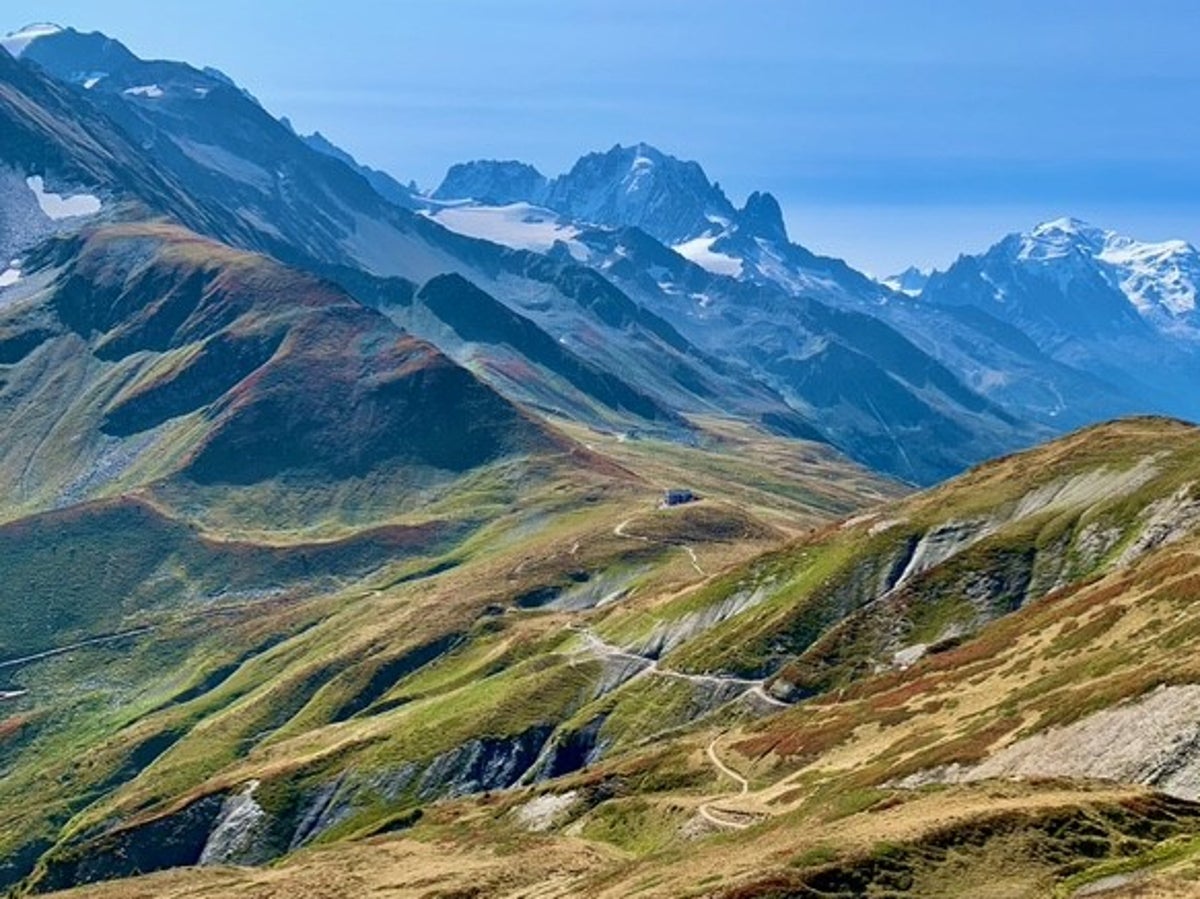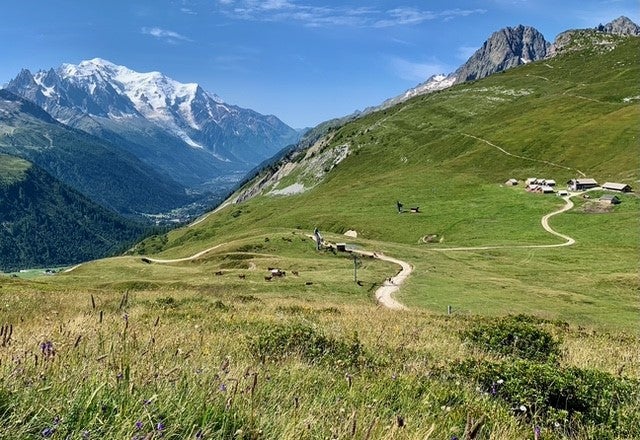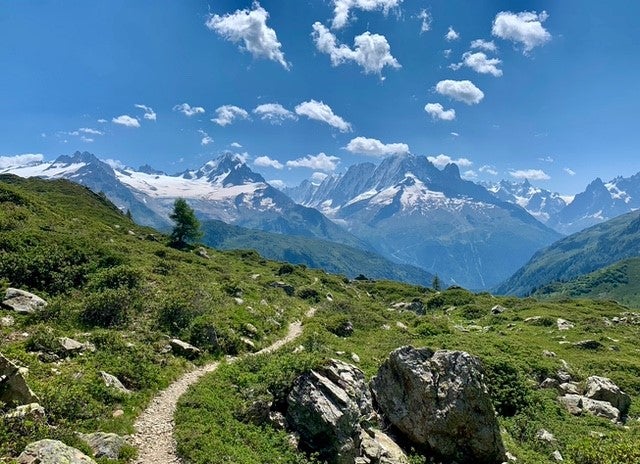
“Top Ten Hikes of the World” lists always feature the Tour du Mont Blanc (TMB). And rightly so; it loops 170km (106 miles) around Mont Blanc, the highest mountain in western Europe which is 4,810m (15,781ft), traversing not one but three countries: France, Italy and Switzerland. Vistas around the Tour du Mont Blanc are superlative and, with a lung-busting 10,251m (33,631ft) meters of ascent, they will, quite literally, take your breath away.
The route
Mont Blanc is surrounded by seven valleys radiating from its core. The TMB links them all via high mountain passes. Chunk the trail down into 11 sections and it starts to form the energetic backbone of a superb two-week holiday. You can start and end anywhere and walk in either direction. The French resort of Chamonix is a logical start/finish point and most people walk the trail in an anti-clockwise direction. The main trail is well sign-posted and is not technically difficult (but avoid “variant” options involving chains and crampons). The TMB does not summit Mont Blanc itself, however: that is an entirely different mountaineering adventure.
How long does it take?
11 days
There is a rare breed of ultra trail endurance runners who complete the TMB non-stop in a phenomenal sub-20-hour annual event. These are world-class athletes with lungs and legs that defy science. Lesser mortals, ie competent, fit walkers, take nine to 11 days to complete the whole circuit.
One week
The Mont Blanc road tunnel slices through the mighty mountain, offering hikers an easy option to split the TMB over two holidays using local coach services to and from Chamonix and Courmayeur (eg year one trek Chamonix to Courmayeur, the following summer complete your circumnavigation from Courmayeur to Chamonix).

A few days
If you don’t want to commit to the whole TMB, base yourself in Chamonix and tick off a few sections of the route, using local transport each day.
11-day itinerary
Sample daily itineraries: +/-18km (11 miles) distance/1,000m (3,280ft) ascent/6-8 hours walking
Day 1: Chamonix Les Houches (Bellevue cable car) to Les Contamines, France
Day 2: Les Contamines, via Col de la Croix Bonhomme is 2,476m (8,123ft), to Les Chapieux
Day 3: Les Chapieux (valley bus), via Col de la Seigne is 2,516m (8,254m), to Refugio Elisabetta, Italy
Day 4: Elisabetta to (Dolonne cable car) Courmayeur, Italy
Day 5: Courmayeur to Lavachey, Switzerland
Day 6: Lavachey, via Grand Col Ferret is 2,537m (8,323ft), to La Fouly, Switzerland
Day 7: La Fouly to Champex, Switzerland
Day 8: Champex to Forclaz, Switzerland
Day 9: Forclaz, via Col de Balme is 2,191m (7,188ft) to Le Tour, France
Day 10: La Tour, via Col des Montets, to Flegere, France
Day 11: Flegere, via Brevent is 2,368m (7,769m) to Les Houches Chamonix, France
How to plan a trip
The TMB does present logistical challenges, but overcoming them is all part of the fun.
You can plan your route and reserve most refuges using one incredibly useful website, autourdumontblanc.com, enabling you to join the dots between each day’s walk.

As you plot your itinerary, bear in mind that walking at altitude can impact stamina and sleep quality, and that the ascent profile of a walk is as important as the distance. Alpine guides indicate the typical number of hours per walk as a good benchmark of effort required. Before you go, practise long, hilly, multi-day walks, with a loaded backpack.
If you’d like hiking buddies or an expert guide, organised group trips are also available (eg exodus.co.uk, keadventure.com). Some even offer luggage transfer.
When to go
Mid-June til late September is TMB season. The main snow melt ends in June, long summer days are a bonus, Alpine flower meadows peak in July and, come September, summer tourists are replaced by glorious autumnal colours.
If you yearn for solitude, avoid the week of the annual Ultra Tour du Mont Blanc event (28 August 2023), when Chamonix and the TMB trail will be ultra-busy, with 10,000 runners and their supporters zipping around.
Packing list
- Quality trail boots
- Collapsible trekking poles
- Sunhat, sunglasses and sun lotion
- Water bottles and energy bars
- Basic first aid kit and blister repair
- Euros: many refuges are cash-only and lack wifi
- Flip-flops and dry, warm kit for evenings
- Sleeping bag/liner
- Earplugs to block out noisy bunk companions

Sleeping
Delight in the rustic charm of ‘refuge’ mountain huts. You’ll be thankful for their warmth, chilled beers, hot meals, and beds. Some refuges offer private rooms, although most have mixed-sex bunk dormitories; all have shared bathrooms and water (sometimes hot!). Bed and half board costs around €60-80 (£53-71). But it’s impossible to put a true price on the experience of staying in these off-grid, remote locations, nestled amid extraordinary Alpine scenery, with sublime starry skies.
Where the trail touches the resorts of Chamonix, Les Contamines, Courmayeur and Champex, you can swap these stripped-back stays for normal hotels.
Eating
It helps to like cheese on the TMB. A hunk of Comte and baguette for lunch? Tartiflette (melted cheese, potatoes, and ham) for supper? “La Vache Qui Rit”,soft, triangular cheese, for breakfast? And repeat... This is Savoie mountain food. You won’t go hungry, and you won’t have to carry much with you. Refuges ensure hikers are fuelled up with breakfast, supper and packed lunches.
Highlights of the TMB
- The views. Impossible to pick one (Col de Balme? Col de la Seigne? Val Ferret?). Each day will reveal stunning scenery: vertiginous mountains, ancient glaciers, and snowy 4,000m (13,123ft) peaks.
- The simplicity of the daily TMB rhythm is a tonic: life slowed to a walking pace, mountain air, summer pastures filled with wildflowers and jingly cowbells.
- Meander through three European countries, witnessing rural life in traditional mountain communities.
- Experience warm camaraderie between fellow hikers relaxing in remote mountain refuges.

Tips
- Underestimate the TMB at your peril. You’ll be climbing more than the equivalent trek to the summit of Everest.
- Book accommodation early (especially Les Chapieux), ideally before Easter.
- Acclimatise in the Alps for a day or so and consider a rest day in Courmayeur.
- Don’t overpack, aim for 10kg maximum.
- Use cable cars where they make sense (unless you’re a route purist).
Apres-hike
First up, treat your weary body to a luxury spa in Chamonix when you finish. QC Terme is bliss. Indulge in a Brasserie du Mont Blancbeer on a cafe terrace by the glacial River Arve, and be sure to take a celebratory ride up the Aiguille du Midi cable car. From Chamonix, the distinctive red cable car shoots up to a giddy 3,842m (12,604ft), seemingly within touching distance of Mont Blanc itself. Survey your route around the massif. This is the 360-degree panorama to beat them all. Mission accomplished.
“Holiday” doesn’t do the TMB justice: the post-trek sense of accomplishment is profound and will leave a lifelong imprint.
Getting there
Chamonix is accessible by flights to Geneva and onward by a 90km (55 miles) mini-bus transfer from the airport. Chamonix is also connected by train, via the scenic Mont Blanc Express Railway.







